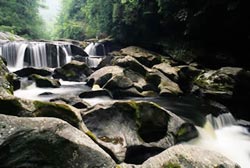Even a Mile of Forest Makes a Difference in Water Quality

Chattooga River in the Nantahala National Forest, NC. Photo Credit: Bill Lea
Results from a small-scale experiment in western North Carolina illustrate the importance of National Forest lands in ensuring high water quality in the Southern Appalachian region. Conducted by scientists from the USDA Forest Service Southern Research Station (SRS), the study, published in the January 2006 issue of the journal Water, Air, and Soil Pollution, showed that the quality of water in streams from an area heavily affected by urbanization was significantly improved by its passage through streams flowing in undeveloped forested areas.
For the experiment, Jim Vose and Barry Clinton, researchers from the SRS Coweeta Hydrologic Laboratory in Otto, NC, located a setting where a stream carried water from a small town into a fork of the Chattooga River while passing through National Forest land. They set up three sampling sites: the first below the town where the stream enters the National Forest, the second about a mile further down where the stream (now a fork of the Chattooga River) exits the National Forest, and the third reference site on a small, undisturbed stream which lies entirely in the National Forest.
“There’s a waste treatment facility a little over half a mile up from where the stream enters the National Forest,” says Clinton. “We chose the first sampling site to pick up the cumulative effects of wastewater treatment and other non-point pollution sources such as housing developments, stormwater runoff, and roads.”
Samples were collected weekly for over a year using automated samplers. Data was collected on water chemistry and total suspended solids, particles that range from soil to various types of organic matter. Coming from a wide range of sources, these solids increase after storms, the proportion of this increase one indication of conditions around a stream. The researchers also collected streamwater samples from all the sites to determine bacterial populations.
Findings showed a definite “cleaning” affect on the stream from passing through just a mile of National Forest, with evidence of significant reductions in concentrations of chemicals such as nitrates, ammonium, and phosphorous. In response to storms, total suspended solids increased to a higher level at the urban sampling site and stayed higher longer, probably due to more impervious surfaces and land disturbances that increase sediment loading into streams. Bacterial populations did not change much between the two sites, and, though differing greatly from those at the reference site, were well below standards established by the U.S. Environmental Protection Agency.
“Factors affecting water quality vary so greatly across landscapes, and we advise caution in applying the specific results of this study to all situations,” says Vose. “But the patterns we observed do fit with those found in other studies, and suggest that stream sections in undeveloped forests can improve water quality in areas where the headwaters have been heavily affected by urbanization or other land uses.”
For more information:
Barry Clinton at 828-524-2188 x124 or bclinton@fs.fed.us
Jim Vose at 828-524-2188 x114 or jvose@fs.fed.us
Media Contact
All latest news from the category: Ecology, The Environment and Conservation
This complex theme deals primarily with interactions between organisms and the environmental factors that impact them, but to a greater extent between individual inanimate environmental factors.
innovations-report offers informative reports and articles on topics such as climate protection, landscape conservation, ecological systems, wildlife and nature parks and ecosystem efficiency and balance.
Newest articles

Machine learning algorithm reveals long-theorized glass phase in crystal
Scientists have found evidence of an elusive, glassy phase of matter that emerges when a crystal’s perfect internal pattern is disrupted. X-ray technology and machine learning converge to shed light…

Mapping plant functional diversity from space
HKU ecologists revolutionize ecosystem monitoring with novel field-satellite integration. An international team of researchers, led by Professor Jin WU from the School of Biological Sciences at The University of Hong…

Inverters with constant full load capability
…enable an increase in the performance of electric drives. Overheating components significantly limit the performance of drivetrains in electric vehicles. Inverters in particular are subject to a high thermal load,…





















